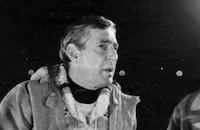Elmer Bernstein's score for the original The Magnificent Seven (1960) was an instant classic. A version of the theme by guitarist Al Caiola hit the Top 40 in 1961 but there were numerous others, even one done to a cha-cha rhythm! Not surprising for somebody with well over 200 film scores to his credit, Bernstein reused parts of the original music in the sequels to keep continuity among them. But you don't get to be a multiple Oscar nominee by goofing off so there's still plenty of music unique to Guns of the Magnificent Seven.
A remake of Akira Kurosawa's Seven Samurai (1954), the first Magnificent Seven had been such a huge hit that it resulted in Return of the Seven (1966) and then Guns of the Magnificent Seven. (The Magnificent Seven Ride would follow in 1972 and still later a brief TV series.) Filmed in Spain like most spaghetti Westerns, Guns of the Magnificent Seven featured none of the original actors though Fernando Rey (as Quintero) had appeared in Return as a priest. Rey's career was a long one with well over 200 films, from appearances in Mexican "B" horror films to winning a Best Actor award at Cannes for Carlos Saura's Elisa, My Life (1977). Guns of the Magnificent Seven also marked the movie debut of Bernie Casey, a former wide receiver with the San Francisco 49ers and Los Angeles Rams who would later act in about 40 other movies. The cast is filled with such now familiar faces as Joe Don Baker (Walking Tall, 1973), James Whitmore (Battleground, 1949) and Monte Markham (Baywatch, 1989-2001). Brought in to direct was Paul Wendkos, a TV veteran from The Rifleman (1958-1963) and The Wild Wild West (1965-1970), who later specialized in made-for-TV movies.
Producer: Vincent M. Fennelly
Director: Paul Wendkos
Screenplay: Herman Hoffman
Cinematography: Antonio Macasoli
Film Editing: Walter Hannemann
Original Music: Elmer Bernstein
Principal Cast: George Kennedy (Chris), James Whitmore (Levi Morgan), Monte Markham (Keno), Reni Santoni (Max), Bernie Casey (Cassie), Joe Don Baker (Slater), Michael Ansara (Colonel Diego), Frank Silvera (Lobero).
C-106m. Letterboxed.
By Lang Thompson


























